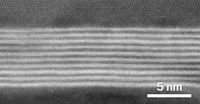Advertisement
Grab your lab coat. Let's get started
Welcome!
Welcome!
Create an account below to get 6 C&EN articles per month, receive newsletters and more - all free.
It seems this is your first time logging in online. Please enter the following information to continue.
As an ACS member you automatically get access to this site. All we need is few more details to create your reading experience.
Not you? Sign in with a different account.
Not you? Sign in with a different account.
ERROR 1
ERROR 1
ERROR 2
ERROR 2
ERROR 2
ERROR 2
ERROR 2
Password and Confirm password must match.
If you have an ACS member number, please enter it here so we can link this account to your membership. (optional)
ERROR 2
ACS values your privacy. By submitting your information, you are gaining access to C&EN and subscribing to our weekly newsletter. We use the information you provide to make your reading experience better, and we will never sell your data to third party members.
Materials
First Transistors Made Of 2-D Materials
Electronics: The fast, ultrathin devices could enable sharp, low-power flexible displays
by Prachi Patel, special to C&EN
May 8, 2014
| A version of this story appeared in
Volume 92, Issue 19

Two independent research groups report the first transistors built entirely of two-dimensional electronic materials, making the devices some of the thinnest yet. The transistors, just a few atoms thick and hence transparent, could lead to bright, bendable, high-resolution displays.
Both groups’ devices signal important progress, says Deji Akinwande, an electrical engineer at the University of Texas, Austin, who was not involved in either study. “Flexible and transparent transistors are important for future flexible smart devices,” he says.
In two new studies, the research teams, one at Argonne National Laboratory and the other at the University of California, Berkeley, used 2-D materials to make all three components of a transistor: a semiconductor, a set of electrodes, and an insulating layer to keep the other two parts separated in some areas. Such all-2-D transistors are smaller than their silicon-based counterparts and would allow for a super-high density of pixels in next-generation displays.
Saptarshi Das, Anirudha V. Sumant, and their colleagues at Argonne made flexible transistors using graphene for the electrodes, tungsten diselenide (WSe2) for the semiconductor, and hexagonal boron nitride as the insulator (Nano Lett. 2014, DOI: 10.1021/nl5009037). Electrons travel in the devices about 100 times faster than in amorphous silicon devices used to drive today’s flat-panel displays. The transistors’ high electron mobility means the devices can switch faster. Switching speed dictates a display’s refresh rate and is necessary for high-quality video, especially 3-D video.
The UC Berkeley group, led by electrical engineer Ali Javey, made similar transistors, except they used molybdenum disulfide (MoS2) as the semiconductor (ACS Nano 2014, DOI: 10.1021/nn501723y). Their transistors have an electron mobility about 70 times higher than that of amorphous silicon devices.
All-2-D transistors have one major limitation, says Vitaly Podzorov, a physicist at Rutgers University: No good methods currently exist for making large-area films of WSe2 and MoS2. In both studies, the research teams exfoliated flakes of the materials from crystals using Scotch tape. Nevertheless, Podzorov says, these two proof-of-concept demonstrations show the promise of 2-D transistors.




Join the conversation
Contact the reporter
Submit a Letter to the Editor for publication
Engage with us on Twitter